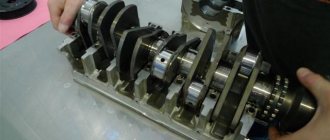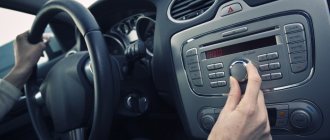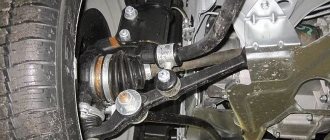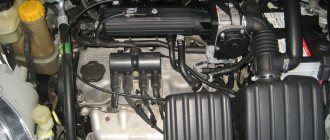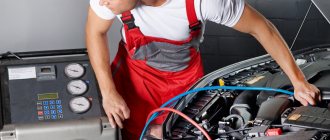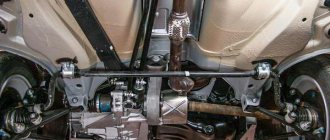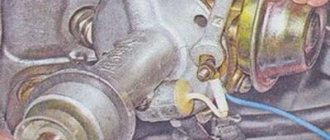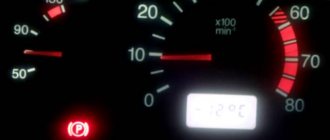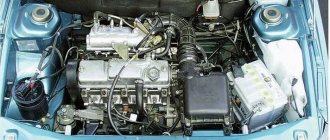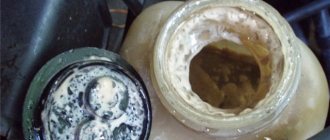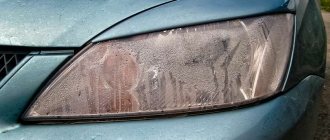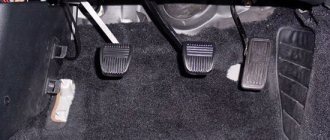Often on numerous forums dedicated to automotive topics, you can read topics about knocking in the engine or cranked bearings. This is an emergency situation in the internal combustion engine. When they say that the liner has rotated, this means that the plain bearings on the crankshaft and on the connecting rods have been torn out of their seats and have become unusable. This is a serious breakdown that happens quite often. Car enthusiasts see the reason in low-quality motor oils from an unknown manufacturer.
But there are many more reasons, and they are not directly related to the lubricant and its quality. To prove this, there are many examples where main bearings fail if branded original oil is poured into the engine. Or vice versa - bearings operate for hundreds of thousands of kilometers on average quality oils. Let's figure out why the crankshaft liners rotate, what factors influence this, and what is the main reason for this phenomenon.
Why does the connecting rod bearings or crankshaft bearings turn?
The connecting rod or crankshaft bearings are plain bearings, which are additionally supplied with engine oil from the engine lubrication system. This solution allows loaded parts to move freely and easily, while achieving a pairing of loaded elements in which there are no gaps or backlashes. Such sliding bearings should be understood as a high-strength steel sheet of a special shape, on which a special anti-friction coating is applied.
Rotating connecting rod bearings or crankshaft bearings is a serious problem that must be corrected immediately. Most often, the driver becomes aware of a problem due to the appearance of a distinct, characteristic connecting rod knock or knock of the engine crankshaft. Further operation of the internal combustion engine in which the liner has been rotated is highly not recommended, since breakdowns of this kind cause significant damage not only to the associated parts, but also to other components of the power unit. Next we will talk about what to do if the connecting rod bearing has turned, what the cause and consequences of such a breakdown could be.
What's the result?
Taking into account the above information, we can conclude that the appearance of knocking in the engine is a sign for immediate cessation of operation of the vehicle. It should also be taken into account that the condition of the liners is greatly influenced by the operating temperature of the power unit. In other words, engine overheating can lead to cranking of the connecting rod or main bearings, engine jamming, etc. In this case, the engine may become completely unusable, as the crankshaft bed breaks, the crankshaft itself, the cylinder block, etc. fail.
As for engine oil, it is necessary to use only those fuels and lubricants that meet all the requirements and necessary approvals of the power unit manufacturer. Also, the oil and oil filter must be changed promptly to prevent dirt and mechanical particles from getting into the lubricant. The lubrication system itself also deserves increased attention, since decreased performance or malfunctions can lead to oil starvation, which significantly increases the risk of bearings turning.
Finally, we add that the gasoline engine needs to be warmed up after a cold start, then you need to drive without loads until the power plant reaches operating temperatures. In the case of a diesel engine, the engine warms up while driving; it is not recommended to sharply load the unit until it is completely warmed up. It should also be remembered that both a new engine and a motor after repair need to be run in, since loaded pairs and mating elements need to be ground in.
The crankshaft clamps the shaft on the liners
I bore crankshafts from trusted boring companies, and I don’t experience any problems when assembling the engine. But if you bored the crankshaft and the boring machine made a mistake, and the crankshaft is clamped by the liners, or, on the contrary, is very loose, then a problem arises in installing the crankshaft on the engine.
I’ll tell you how to fix it if the crankshaft is clamped by liners, both on the main journals and on the connecting rods.
But first you need to install the liners correctly in the bed of the engine block, since if you install the liners incorrectly, the engine will jam, the photo shows how the liners should be installed correctly on a VAZ engine. But other engines also have liners installed.
Photo. Shows how to correctly install liners into the engine block.
After the liners are installed in the engine block, it is necessary to correctly install and select the thrust half-rings or rings (depending on the engine), in short, it is advisable to install or adjust the thrust half-rings so that there is no longitudinal movement of the crankshaft.
Now we place the crankshaft on the liners and insert the liners into the block cushions; the cushions must be put in their places and the liner lock must be placed to another liner lock. We lightly tighten the pillows, after all the pillows are put in place, we begin to tighten the pillows one by one, and after the pillow is tightened, be sure to try to rotate the crankshaft.
Photo. View of the foil in front of the lining between the pillows.
If, after tightening the cushion, the crankshaft is pinched and it does not turn, it is necessary to loosen the pinched crankshaft journal. This can be done with simple chocolate foil; the photo shows how to cut the foil correctly and how to place it to release the pinched crankshaft journal. It happens that one layer of foil is not enough, so add additional foil until the crankshaft begins to turn. This method is suitable for both main bearings and connecting rods. After picking up and tightening the foil, cut off the excess with a knife; the foil is placed on one side of the pillow, where there are no liner locks.
Photo. Shows how to properly place foil between pillows.
Repair and consequences
Typical situation - the liners have turned. What to do? The problem can be solved in different ways, depending on the nature of the damage. In some cases, you can get by by replacing the liners with grinding the crankshaft. In difficult situations, repairs will be significantly more expensive.
If the connecting rod bearing has turned, this is not a serious problem in modern engines. But this does not apply to the indigenous. It often happens that a damaged liner is simply replaced, and the motor continues to work. Experts do not recommend this approach. The service life of the connecting rod-crankshaft journal pair restored in this way can be greatly reduced. A much more acceptable option is to replace the connecting rod with which the problem occurred. Also, if the liners are turned (including VAZ-2172), the lock on the connecting rod will definitely break. It would be more optimal to bore the crankshaft to the next repair size and completely replace the liners and connecting rods. It is imperative to grind the shaft after turning it.
Installation algorithm
The most common method for solving the problem among many people is to contact a car service. But replacing crankshaft liners can be done by any person who has even the slightest experience in carrying out repairs and has a certain set of tools. To simplify the task, it is worth following a certain procedure.
First you need to check the gap located between the liner and the crankshaft. The test is carried out using a calibrated plastic wire, which can be found on the required neck. Then the cover is mounted together with the liner, they are tightened with a certain force corresponding to a value of 51 Nm. Worth using for measurement. After removing the cover, the size of the gap will be similar to the degree of compression of the wire. Using the nominal gap, you need to evaluate the resulting parameter, the value of which is different for each individual brand. If it becomes clear that the gap exceeds the nominal value, that is, the degree of compression, then you cannot do without installing repair parts.
Reasons for rotating liners
So, the crankshaft is a part that works in harsh conditions, and it has to withstand enormous loads in extreme temperatures. In order for the mechanism to be securely held on the axis and to ensure the correct operation of the entire crank mechanism, liners are needed. The journals on the shaft act as an internal race. Inserts - as external ones.
Consequences of rotating the bearings
Let's start with the fact that turning the connecting rod bearings of the engine when a breakdown is detected in a timely manner is a less serious problem compared to turning the crankshaft main bearings. If the problem is detected late, then the consequences for the internal combustion engine may be different. It happens that after cranking the connecting rod bearing, the engine may require an expensive overhaul.
A common situation is when a cranked connecting rod bearing is simply replaced with a new one and the engine continues to run. Note that it is not recommended to do this due to the fact that the service life of the connecting rod-crankshaft journal coupled pair repaired in this way can be greatly reduced (by 60-70%). A more acceptable option is considered to be the approach of changing the connecting rod in which the liner was turned. Also, the connecting rod often needs to be replaced due to the fact that as a result of turning the liner, the connecting rod lock breaks. The optimal method of repair is considered to be boring the crankshaft and replacing the bearings/rods.
Grinding the crankshaft after turning the liner is usually a necessary operation, since scuffs appear on the journal. After disassembling the engine, the crankshaft must be measured, after which it is bored, taking into account the subsequent installation of new bearings of repair size. This is the only way to achieve the required condition of the surfaces and the correct tension of the liner after installation.
Repair
Replacing main bearings requires wrench and screwdriver sets and a micrometer. Repair of main liners includes several operations.
- First of all, you need to provide access to the car from below. That is, it should be installed above an inspection hole or on an overpass.
- Remove the negative wire from the battery terminal.
- Next, dismantle the engine sump (this is the easiest way to access; you can start disassembling from above and hang the engine).
- After this, the crankshaft rear oil seal holder is removed from the cylinder block.
- Then remove the camshaft drive cover with the gasket.
- Then remove the chain from the crankshaft sprocket-pulley.
- Next, you need to mark the relative position of the bearing caps relative to the cylinder block and the connecting rods relative to their caps.
- Then, using a 14mm wrench, unscrew the nuts of the connecting rod cover and dismantle it with the liner.
- These operations are repeated for all connecting rods.
- When completed, the lids are moved up.
- Then the main bearings are removed from the caps and connecting rods.
- Next, use a 17 wrench to unscrew the bolts of the crankshaft main bearing caps.
- First, remove the cover of the last one.
- It opens access to the thrust half-rings in the grooves of the rear crankshaft support. They are removed by pressing on the ends with a thin screwdriver.
- These operations are repeated for the remaining bearing caps. In this case, you need to hold the crankshaft. It should be noted that the covers are designated by numbers, and the countdown is from the toe of the crankshaft.
- It is then removed from the crankcase.
- First, the connecting rod bearings are removed, and then the crankshaft main bearings.
- The crankshaft should be inspected for damage. If they are present, the part is changed.
- The connecting rod and main caps are also examined by measuring with a micrometer. The obtained data are correlated with the tabular ones.
- If necessary, parts are polished. In this case, you will need to measure them to calculate the repair size of the liners.
- The crankshaft is cleaned by washing with kerosene and blowing out the cavities.
- Then new bearing shells are installed.
- Thrust half rings are mounted in the grooves of the fifth bearing bed with grooves towards the crankshaft.
- Next, check the gap between these parts. The normal value is considered 0.06-0.26 mm. If it is more than 0.35 mm, use rings of increased thickness.
- The crankshaft is installed in the block, having previously been lubricated with oil.
- Then install the bearing caps and check the freedom of rotation of the crankshaft.
- Connecting rods, liners and covers are installed on it.
- Then the oil pan is installed.
- After this, install the crankshaft holder with the rear oil seal.
- Finally, the remaining parts are installed.
- Finally, the tension of the timing chain, alternator belt and ignition timing are adjusted.
Causes of connecting rod bearing failures
Internal combustion engine repair specialists see several reasons why plain bearings rotate. This is often due to excessively thick oil, which contains metal particles. Lubricant with chips has an abrasive effect on the liners. Often there is a complete lack of oil. This especially affects cars with worn oil scraper rings. Some of the lubricant simply goes “down the pipe.” As a result, the liner rotated and the engine was sent for repair. The bearing caps may not be tightened sufficiently together. And finally, one more reason. This is too thin oil. Such products are especially harmful for motors operating under high loads.
Preference violation
If the liners have turned, this could be the reason. This will not happen in production cars assembled at the factory by qualified specialists. But if the engine has already been repaired, then, most likely, the selection of liners was made incorrectly and the tension was broken.
When the motor is running, the liners experience increased friction torque. This moment tends to rotate the liner. And due to the reduced force that holds the part in place, the risk of turning increases significantly. Under the influence of an uneven load, a weak fit of the friction bearing causes the liner to vibrate. The lubricating film is also damaged. As a result, the part rotates, and the retaining threshold is unable to prevent this.
Mechanical wear
The first reason why the main and connecting rod bearings are replaced when repairing an engine is wear. Parts wear out due to mechanical loads. Many people try to save their earbuds, but it is useless. Physics is involved here, and physical processes cannot work any other way. Wear and tear is inevitable. The anti-friction layer on the liner wears off over time. This leads to free movement of the crankshaft. Backlashes appear. As a result, the oil pressure decreases, quite significantly. On most engines that are highly reliable, if the liner turns, this indicates their wear.
What to do if the connecting rod bearing has turned
If you notice symptoms of rotating bearings, you should go to a car service center or to your garage if you are going to replace them yourself, but it is better to turn off the engine and transport them by tow or tow truck, if possible.
Turning the connecting rod bearings is less costly and labor-intensive, if you stop operating when knocking is detected, than turning the main bearings. If you did not pay attention to extraneous knocking noises in the engine and continued to drive in this condition, then, perhaps, the cranked connecting rod bearings will lead to an expensive overhaul of the engine.
Basically, if one connecting rod bearing has turned, then it is replaced with a new one and the repair is complete. In this case, since the connecting rod itself has not been changed, the service life of the repaired crankshaft journal-connecting rod pair will be less than expected.
A desirable step in replacing a connecting rod bearing is to also replace the corresponding connecting rod. It often happens that if the connecting rod bearing is turned, the connecting rod lock breaks.
The optimally effective repair for bearing problems is considered to be boring the crankshaft and replacing the bearings with connecting rods. The crankshaft neck on which the rotated liner sat has nicks and scratches. Therefore, it is necessary to grind the crankshaft. All connecting rod bearings have the same dimensions and are completely interchangeable with each other.
The procedure for replacing connecting rod bearings in a garage:
- We install the car over the pit.
- We install anti-roll bars (shoes).
- Unscrew and remove the exhaust pants.
- If the engine design provides for various suspensions for the gearbox, then unscrew and remove them too.
- Remove the oil pan. It is convenient and quick to use a screwdriver for this task.
- Unscrew the oil receiver.
- We unscrew the bridge fastenings and remove it.
- Now you have access to the internal combustion engine crankshaft. Raise the front wheel with a jack and turn the raised wheel in 4th or 5th gear.
- We turn the wheel and set the connecting rods not strictly vertically, but at an angle.
- Next, unscrew the nuts securing the connecting rods and remove the bed in which the connecting rod bearing is seated with tension.
- We remove the second liner from the crankpin (below, the video clearly shows how to do this).
- We look at the removed sliding bearings. Rotated bearings have scratches and mechanical damage, often flattening them.
- We wipe the seats of the beds for the connecting rod bearings and install new bearings in them.
- To prevent the lower bed from being confused (since it can be rotated 180 degrees and installed in a different position), half numbers are stamped on the ends (part of the number is on the end of the bed, the other half of the number is on the connecting rod). There are also numbers stamped on the bottom of the bed, which can be used to compare where the numbers on other beds point.
- We do the installation. We tighten the bed nuts with a torque wrench (you cannot overtighten or under-tighten). For different engines there are different tightening torques. There are tables with tightening torques for specific engine parts.
Replacement
All official manuals recommend replacing the crankshaft liners with a complete disassembly of the engine, but in fact, this is not necessary. Everything can be done directly from the car. And if with connecting rod bearings everything is more or less clear. Simply unscrew the head, pull out the old part, and then install a new liner. But questions arise with the rest, because at first glance you can’t get to them without removing the crankshaft. But here the experience of naval mechanics comes to the rescue. On large marine diesel engines, the length of the crankshaft can reach 10-15 meters; accordingly, it is not removed to replace the bearings. There is a good technique that allows you to do this directly on the engine. The task of the auto mechanic is to adapt it to his goals. Before starting work, you need to drive the car onto an overpass or inspection hole. This will make access to the motor from below absolutely free. The protection (if any) is also removed and the oil is drained. After this you can start replacing:
- The box is removed. It's better to do this in advance. In some cases, you can do without this, but it is better to prepare ahead of time, this will allow you to waste less time in the future;
- The front cover is removed. The camshaft drive belt (chain) becomes loose. It is better to remove it completely;
- The starter is dismantled;
- Next you need to remove the pan. In principle, there should not be any special problems with this work. But, on some models the front beam will interfere. In this case, you will need to unscrew the motor mounting pads and lift it slightly. After this, you can freely pull out the pallet;
- This will take you to the crankshaft. Usually, replacement starts with the connecting rod bearings. Everything is simple here. Unscrew the screws securing the head, pull out the old bearings, and then install new parts. Before installation, lubricate the bearings with engine oil;
- Before replacing the main bearings, the crankshaft should be lowered. To do this, loosen its attachment to the flywheel. It is enough to lower it by 10-15 mm
; - Next, pull out the liners. The easiest way to accomplish this is to make a device like an aluminum rivet. It is inserted into the grease supply hole and the bearing is pushed out. Sometimes drivers use steel rulers for this, but in this case the working surface of the crankshaft can be damaged.
After removing the liner, be sure to inspect its condition. If simple wear is visible without scuffing, then you can safely install new spare parts. In the case of visible damage, it is advisable to remove the crankshaft and grind it. Reinstalling the liners in most engine models is done by hand. If this fails, you can use the same device that was used to remove the bearings. Lubricate the bearings before installation
Pay attention to the correct installation of the parts; the antenna must fit into the groove intended for it. When assembling, you must remember that the screws must be tightened with the force specified by the manufacturer. Therefore, use a torque wrench to final tighten the fasteners. This will prevent parts from unscrewing spontaneously.
Conclusion. Every car enthusiast has encountered engine malfunctions at least once. Moreover, wear can appear after 100,000 kilometers or after 500,000. Much depends on the specific model, as well as the characteristics of operation. Many people are interested in how to replace crankshaft bearings without removing the engine. It is quite possible to do this, but it will still be easier to remove the motor, and the reliability of repairs directly on the car will be lame
This will prevent parts from unscrewing spontaneously. Conclusion. Every car enthusiast has encountered engine malfunctions at least once. Moreover, wear can appear after 100,000 kilometers or after 500,000. Much depends on the specific model, as well as the characteristics of operation. Many people are interested in how to replace crankshaft bearings without removing the engine. It is quite possible to do this, but it will still be easier to remove the motor, and the reliability of repairs directly on the car will be poor.
Signs of a rotated liner
Rotation, displacement or destruction of the liners can be diagnosed immediately even by an inexperienced but informed driver. There is a clear indication that the crankshaft or connecting rod bearings have turned. This is a knocking noise at the bottom of the engine, above the sump.
When starting a cold engine, there may be various squeaks and whistles, for example, when frozen rubber belts begin to move, pumps rotate, etc. But these are one-time sounds. When the liners are turned, the knocking does not stop, but increases. An emergency gap or play is formed between the connecting rod and the crankshaft journal, and the connecting rod simply hits the crankshaft journal, producing a fairly loud metallic knock.
Communities › Lada 2110, 2111, 2112, 112, Bogdan › Blog › Did the liner really turn?
Hello everyone, in general the situation is like this. I bought a 2110 16V, it works great at idle, at rpms of 2500 and above a knocking noise starts, a knocking noise from the manifold. I was doing the undercarriage and casually asked the master “what could it be?”, he said “I guess it’s a liner.” Question: could this be an insert, considering that I have already driven about 2000 km since I bought the car, the sound has not progressed and I don’t know how long they drove before me. The video is not mine, but the sound is very similar and not at idle, but at rpm above 2500.
Comments 51
Well, according to the video, one valve knocks - that’s okay, but the second guttural sound brings up very bad thoughts. And screwed earbuds won't make much sound. Strange mechanics who determine this by ear, I wouldn’t let them fix my car)))
This is something with a piston turned. Either the connecting rod or the piston is moved in the cylinder, but not the liner 100%.
The oil receiver mesh is simply clogged and when you increase the speed you are starved of oil. To replace: oil, oil filter, oil receiver mesh, and most importantly, flush the engine with an intermediate cheap oil filter and oil. To begin with, drain the oil and unscrew the pan - It could be the most banal thing - the sealing ring of the oil pickup tube needs to be replaced or just a bolt has come loose, and at the same time you can check the mesh. It would also be nice to know when and how the oil was changed, from which to which and what was done. Don't drive it like that, you'll lock up the engine.
Thank you very much, very good advice, I’ll definitely check it out.
I don’t know about everyone else, but I hear two sounds, especially at the beginning of the video, one is definitely a hydraulic device, and the second is muffled, either the microphone is making so much noise, or there are a lot of options, starting from the pump, ending with the beating of the piston on the cylinder, as it warms up the sound seems to go away. But it’s 100% not the liner, if the liner turns, you won’t be able to drive for a long time, the pressure will drop (the hydraulics will definitely rattle) and you can even catch the wedge. So my advice is to measure the oil pressure, if it doesn’t drop below 1.5-1.7 when hot, then replace the hydraulics, and it’s better not to look for which one, but to change everything at once, it will be cheaper.
Source
Rotating the crankshaft connecting rod bearings
This is also one of the popular faults. Many car owners have faced this problem. But not everyone knows about the reasons. Let's figure out what happens to the element. The connecting rod bearing plate is quite thin. It is installed on a special seat. The outer walls on the half rings have special protrusions, which, even in a non-run-in and undeveloped engine, rest against the front part of the cylinder block. At a certain point, the seat simply cannot hold the connecting rod bearing. The result is a typical situation - the liner has turned. The plate not only rotates, but also sticks to the crankshaft journal. In this case, the engine stalls and will not start again.
see also
Comments 31
I had the same failure... I took the connecting rod apart. And everything was sharpened... in general, long live the first engine repair. 1.5 years of normal flight... the only thing is that it is better to change the valve and camshaft seals once every 15,000 km. Although I take Erling...but the burn begins after 10,000 km. and by 15,000 the real oil spill begins there. I take oil at the latest Kutenkuller
Rotated the bearings on the 3rd connecting rod. Crankshaft grinding, connecting rod grinding. Repair inserts and off you go. Greetings from Fordovod
you need to find the reason why it turned / the elbow is clogged / check the oil pump and then everything else
The knee didn’t clog, the pump applied normal pressure, the pressure in the head was 4 for cool, 1.5 for hot at xx with the liner turned, in my town everyone turns the liners on the second cylinder
The knee didn’t clog, the pump applied normal pressure, the pressure in the head was 4 for cool, 1.5 for hot at xx with the liner turned, in my town everyone turns the liners on the second cylinder
what does it mean in your town and I/ lei synthetics 5v30 extra drive hado
I understand that there were 6 people who had the liners turn on such engines, and all of them had the second turn, I drove a hado, but I’ll probably change the oil, it’s precious and it doesn’t do much good, there’s a lot of deposits in the engine, and I took the oil from the officials, although everything May be
Your prices are crazy))). Nobody wants to take them from us like dirt for a hundred square meters.
Buy it up. By the end of the year you will be selling them throughout Russia. $150-200 Particularly valued in the Russian Federation (Russian Federation is a state in Eastern Europe and Northern Asia, our Motherland)
, 3A, DZ, SD, ABK, ADR.
Preference violation
If the liners have turned, this could be the reason. This will not happen in production cars assembled at the factory by qualified specialists. But if the engine has already been repaired, then, most likely, the selection of liners was made incorrectly and the tension was broken.
When the motor is running, the liners experience increased friction torque. This moment tends to rotate the liner. And due to the reduced force that holds the part in place, the risk of turning increases significantly. Under the influence of an uneven load, a weak fit of the friction bearing causes the liner to vibrate. The lubricating film is also damaged. As a result, the part rotates, and the retaining threshold is unable to prevent this.
Connecting rod bearing - what is it?
There is one very highly loaded part in an internal combustion engine. The element is not mounted on traditional bearings. Due to the design features used, the design of these very parts may be different. But the constant improvement of engines has led to the fact that a sheet of steel coated with a special anti-friction layer is now used. This is the connecting rod bearing. These elements are installed in special places - beds. The inserts are fixed. The need to fix these parts is due to the fact that they have holes for oil movement. They must match those in bed. Also, by means of fixation, friction is ensured on special surfaces designed for this purpose. The connecting rod liner is a kind of protective element, thanks to which the service life of the crankshaft is significantly increased.
Features of operation
During engine operation, the liners are subject to constant loads due to mutual friction of these parts. Therefore, the installation of the main bearings must be carried out with reliable fixation to avoid their displacement by the rotating crankshaft. To achieve this, measures are taken:
- Firstly, they take into account the characteristics of friction of the parts in question, which manifests itself when they slide against each other under load. Its value is determined by the friction coefficient and the magnitude of the load on the interacting parts. Therefore, to ensure reliable retention of the liners, the impact of the crankshaft on them should be reduced. For this purpose, the coefficient of friction is reduced by using antifriction materials that are applied to the surface of the liners.
- Secondly, the main liners are mechanically held in place. Two methods are used for this. These elements are installed with interference specified structurally. In addition, on each of them there is an additional element called a tendril, which also serves for holding.
The difference between main bearings and connecting rod bearings
Connecting rod bearings are installed in the bed between the connecting rod and the crankpin of the crankshaft. The main bearings are installed on the main journals of the internal combustion engine crankshaft.
Main plates differ from connecting rod plates in diameter and thickness. The main ones are thicker and have oil channels through which oil is supplied from the main shaft to the connecting rod bearings.
Description of how the earbuds work
Before we move on to describing the signs, causes and methods for eliminating wear of liners, it is necessary to understand their purpose, types and principle of operation.
There are two types of crankshaft liners - main and connecting rod. In essence, the liners are plain bearings, and their task is to withstand significant loads that occur between the connecting rod and the crankshaft journal. In modern machines (in most cases), the liners are made of ductile aluminum alloys (usually aluminum and tin). They are coated on top with an anti-friction compound.
The main bearings are located between the crankshaft and the place where the crankshaft passes directly through the engine body, in seats called “beds”. The main bearings have holes in their design designed for better oil drainage. That is, the main bearings are sliding bearings for the main journals of the crankshaft. But in fact, the crankshaft rests and rotates on the main bearings.
The connecting rod bearings are located at the bottom of the connecting rod head. And the connecting rods, in turn, are secured using connecting rod bearings on the connecting rod journals of the crankshaft. The function of the connecting rod bearings is that they act as plain bearings for the lower ends of the connecting rods and the crankpins of the crankshaft.
Wear of the liners implies a significant increase in their gaps (the greater the increase, the worse). As a result, the pressure in the engine lubrication system drops. Usually in such cases, a light (oil can) lights up on the dashboard, symbolizing that the oil pressure has dropped significantly. This is especially common on a hot engine, when the oil viscosity is minimal. In such cases, drivers say that “the bearings do not hold oil.” Wear of the liners is a very dangerous problem that can lead to great wear and tear on other engine parts and the engine as a whole. And this can lead to a significant reduction in their resource and damage.
The sound from the knocking of the main liners is usually dull, with a metallic tint. It is easy to detect when the engine is idling, and after that the speed increases sharply (sharply press the gas pedal). At the same time, a large load is placed on them and a knock appears. The same should be done with the connecting rod bearings.
It is not difficult to find out which cylinder the liners are knocking on. To do this, you need to turn off (unscrew) the spark plugs on a gasoline engine or the fuel injectors on a diesel engine one by one. If the mentioned knocking noise disappears when a spark plug is unscrewed, it means that there is a problem in this cylinder.
Why does the connecting rod bearing rotate?
The bearings of the connecting rods and crankshaft of the internal combustion engine are plain bearings that must be generously lubricated in order to perform their functions. The crankshaft journals and connecting rod bores fit tightly without play or gaps, but thanks to lubrication, the friction force of the mating pairs is minimal.
Rotation of the connecting rod bearings and crankshaft requires immediate repair. You cannot operate a car with such damage to the engine, because further destruction of parts or components of the internal combustion engine may occur. This breakdown can be determined by ear; a knocking sound of the crankshaft and connecting rod can be heard.
Liners, also known as sliding bearings, are placed in places called bearing beds. The inserts must be fixed. If the liners have holes, they must be aligned with the holes in the mating part.
Did you know that the type of locking and overtension of the differential is responsible for the cross-country ability and controllability of the car?
The main reasons for rotation of the liners:
- The inserts were not fixed sufficiently;
- the inserts are stuck.
The crankshaft rotates relative to the liners, the surface of which is protected by antifriction (anti-rubbing) material. To prevent the liners from shifting and turning along with the engine crankshaft, they are held in place by special antennae. They are also installed in tension, which were calculated by the manufacturers.
The greater the load on the crankshaft, the less the oil film (layer, cushion) is created. And if there is still excessive vibration, then the oil protective layer is destroyed and the friction force increases sharply, which makes it more and more difficult for the liner to stay in bed; the antenna designed to protect against rotation cannot hold the liner.
As a rule, the reason for rotation of the bearings is the lack of lubrication. For lubrication, there are holes on the main bearings, and grooves on the connecting rod bearings. If these oil supply channels are clogged, the holes and channels are completely or partially clogged, the friction force of the rubbing parts increases, and the effect of oil starvation appears. Due to the lack of lubrication, the liner-crankshaft pair becomes very hot. During heating, the rubbing parts stick to each other. After such welding, the liners begin to rotate.
avtoexperts.ru
In automotive life, the diagnosis of “rotated bearings” is comparable in medicine to, for example, tuberculosis, a curable, but very terrible and unpleasant disease, which will cost a lot of effort and money to overcome. The same goes for turning the liners. This is not a final verdict on the engine, but a clear hint to the owner that he needs to prepare money for expensive repairs. What exactly happens when the liners turn and why it is so difficult to eliminate its consequences - we will tell you in this material.
Connecting rod bearings
What are liners and how do you turn them?
First, of course, you need to understand what earbuds are. Essentially, these are friction bearings, they allow different mechanical parts to rotate in contact with each other without causing damage. The most rotating part of the engine is the crankshaft, so the liners are, for the most part, an element of its design (but depending on the engine, there may be other elements too). When we hear about cranking of liners, we are usually talking about the crankshaft.
Here we need a little theory of internal combustion engines for those who did not study physics well at school. The crankshaft has two types of bearings - connecting rod and main bearings. Connecting rods are used at the point of contact between the crankshaft and connecting rod. On the other side of the connecting rod itself there is a piston, which moves under the influence of a fuel explosion, transmits torque to the connecting rod, and it already rotates the crankshaft through the connecting rod bearings. The main bearings are installed where the crankshaft meets the cylinder block and allow the shaft to rotate in the block.
The photo shows the crankshaft, connecting rods, liners, piston rings and other engine parts
Structurally, the liners are rounded metal plates coated with a special coating that helps reduce friction. No matter what the coating is, it will not save you from contact between two metal parts, so ample lubrication is a prerequisite for the operation of the liners. Depending on the type of spare part or its design, the liner contains either grooves, holes, or channels (and sometimes all together), which are exactly what is needed to supply oil. How exactly the oil is supplied and which routes are the problems of the engineers who developed the engine. We drivers need to know that the bearings will not last long without oil.
Main bearings
The liners have special seats that allow them to be fixed near the lubrication channels and clearly in the place of increased friction of the mating parts. Fixation is provided by special antennae. The rotation of the liners that we describe is precisely the situation in which the liner has either pulled out of its seat, or physically cracked, or has shifted. In general, any problems with the liners are usually called rotation.
Causes of the problem
The release of the liner for a “walk” does not happen without additional reasons. And in most cases, these reasons are related to lubrication problems. When the crankshaft rotates, all liners experience high friction, which is reduced to reasonable levels through the use of lubricants. Yes, the liners wear out little by little even with enough oil, but this is a very long process, stretching over hundreds of thousands of kilometers. Rapid cranking occurs when there is something wrong with the lubricant.
The first option is that the oil is very old. If the lubricant is not updated, it loses its properties and no longer reduces the friction force to acceptable values. The load on the liner increases and it can no longer stay in place.
Rotated liners in BMW M5 E39 engine
The second option is the wrong oil. The lubricant characteristics recommended by the manufacturer are usually not taken out of thin air, but are calculated based on the design of the motor, for example, the cross-section and number of oil channels. All grooves and holes in the liners work well with oils of a certain viscosity. If it is too thick or too thin, it may not reach the parts in the required quantities. Yes, we ourselves wrote at one time that there is an element of marketing in the viscosity recommendations from the manufacturer and sometimes it is worth being a little critical of it, but they must be taken into account.
The third option is problems with blood pressure. If the oil pressure is too low (there can be many reasons for this), then even the correct oil will not flow to the components, so the risk of turning over increases.
A wedge occurred on the connecting rod journal - the bearings turned. It was necessary to monitor the oil level. Photo - zr.ru
The fourth option is a simple lack of oil. If there is a leak or loss of lubricant, and the driver has not checked the level for a long time and missed this moment, then even with a well-functioning pump, there may not be enough oil for the bearings. And hello, crank.
To be fair, it must be said that not all problems with liners can be explained by problems with lubrication. There is also the possibility of incorrect installation (in factory cars this rarely happens, but after poor-quality engine repairs it happens periodically) or banal abrasion of the liner due to huge mileage, but the second case happens extremely rarely - something else in the engine is more likely to break than the liners will be completely worn out. So usually oil problems.
Natural wear of the main liners in the 3.0 diesel V9X engine
Here I would like to give an example. Any engine can turn the bearings, but in recent years the Korean G4KE has been the unofficial title of champion for this failure. There are a lot of examples where the bearings on it turn over on runs of about 100-150 thousand kilometers. Experts agree that in this case the fault is not the most successful design of the oil pump, which already in the first hundred thousand kilometers suffers from structural play and reduces performance. The lamp does not light up because some pressure does not remain, but the oil supply deteriorates. And the liners are the first to suffer from this due to another feature of the engine - the powerful 2.4-liter engine has a very flimsy crankshaft. Under high load (driving in the mountains or driving on the highway at very high speeds), it works at the limit of its capabilities, which is transmitted to the liners, which turn out to be the weakest element in the entire system and turns them. Let's make a reservation that this is only an example of a specific motor.
G4KE engine crankshaft and bearings. Photo — drive2.ru
How to understand and what to do
We understand what happens to the liners inside the engine and the reasons for this, but what should a driver do who is simply driving a car and has no idea what is happening inside the engine? A symptom of cranking is a knocking noise during operation. There is a loud knocking noise coming from somewhere underneath the engine. Alas, these are all the signs. The engine can knock for other reasons, but it is impossible to distinguish it by ear without some experience. Therefore, it is difficult for an inexperienced driver to confidently diagnose a rotation without disassembling and troubleshooting. That is, if the engine starts knocking, then the safest option is to turn it off as quickly as possible and take the car to a service station on a tow truck. Because it can be different.
The specific damage caused by rotating the liner cannot be assessed without disassembly. Let's imagine that the liner bursts, it stops performing its duties, and at this point the crankshaft begins to get scuffed, which is very bad. And if the liner physically flies out of the seat, then it begins to wander around the engine, it can crumble and clog the oil channels with chips, it can itself damage other elements, it can make a lot of scuffs, there have even been cases of the block being broken through. And a very terrible case is when the liner, under the influence of high temperature, sticks to the crankshaft and begins to rotate with it. Here you get a real meat grinder for engine parts.
Connecting rod after turning the bearings. Photo - zr.ru
Therefore, there is no need to talk about repairs after a twist. Purely theoretically, this could also be a replacement of only the rotated liner, which can be done without removing the engine, reaching the crankshaft from below. But this is a very unlikely scenario; the driver needs to immediately turn off the engine and get lucky. Usually the crankshaft gets damaged when turning, so at a minimum it requires boring to the repair size, or even replacement. Most often, turning the liner ends in a major overhaul of the engine, and not so much because of the consequences of the turning itself, but according to logic. Usually, if the liners are turned, then other engine elements are already worn out, and if you still remove and disassemble the unit, then it is reasonable to change everything so that you don’t have to pay for expensive work a second time.
Damaged crankshaft journals are the consequences of rotating bearings. BMW N57 engine
Another unpleasant side of the liner rotation is that there is no way to prepare for it - neither mentally nor physically. A turn happens abruptly and unexpectedly, and, what’s worst, often on a highway far from services and civilization. Driving a car under its own power, even if the engine does not stall, is finally signing the engine’s death warrant, so you also need to look for a tow truck somewhere and pay for it.
It is difficult to come up with any special prevention that would allow one to avoid such an unpleasant event. Of course, timely replacement of high-quality oil, checking its level and moderate loads while driving will significantly reduce the likelihood of cranking, but these are universal tips for the long life of any engine, not just liners. And the inserts themselves are like soldiers on an invisible front; while they are working, no one thinks about them, and if something happens to them, it’s a disaster.
Author: Alexander Nechaev.
Difference between main and connecting rod bearings
You need to know that there are two types of liners. These are connecting rods and main ones. The first are located between the connecting rod and the crankshaft journal. The root element is similar to the first in its purpose. However, it is located where the crankshaft passes through the engine housing. The inserts vary in size. Dimensions depend on the type of internal combustion engine for which a specific part is made. There are also special repair inserts. They are different from the original new ones installed in the engine. Repair inserts differ only in marks that are multiples of 0.25 mm. So, their sizes are approximately the following - 0.25 mm, 0.5 mm, 0.75 mm, 1 mm.
Signs and causes of wear
Now let's move directly to the types of damage that contribute to wear of the liners and their failure.
Mud erosion
Signs. A sign of mud erosion is the presence of burrs or inclusions of dirt. Sometimes both. In particularly advanced cases, mud erosion can move to areas near the oil holes.
Causes. The reason in this case is low-quality oil, which contains dirt impurities or abrasive materials.
Elimination. It is necessary to check the operation of all moving engine parts. The lubrication system must be checked especially carefully. It also makes sense to check the oil and air purification system (primarily the filters). When assembling the engine, you must prevent dirt from getting into it. After all this, you must definitely change the oil to a new one.
Corrosive abrasion
Signs. We are talking about the presence of corrosive abrasion on the rear steel surface of the liner. As a rule, traces of corrosion are located closer to the connection of the halves of the liner body.
Causes. In this case, there may be several reasons. Among them:
- Reduced pressing force. This leads to slight movements of the liner body relative to the surface of their support.
- The mounting bolts were loosely tightened during installation.
- There are foreign bodies on the contact surfaces of the liner support.
- Prolonged engine operation at high speeds (especially if this occurs frequently).
- Using inserts with inappropriate dimensions (width).
Elimination. According to the different causes of the problem, the resolution methods may also be different. In particular:
- Tighten the mounting bolts to the torque recommended by the vehicle manufacturer.
- Inspect the seat diameter of the liner support.
- Check the cleanliness of the contacting surfaces between the liner and the support.
- Use the insert of the prescribed size (width).
- Try not to use the engine at high speeds for a long time.
Prevention methods
As mentioned above, partial failure of the liners entails increased wear of the engine, and in particular, its lubrication system. Therefore, in order to prevent such a situation, it makes sense to carry out periodic preventive measures. So, first of all, you need to use the engine oil recommended by the car manufacturer. This is especially true for its viscosity. You should not buy very cheap oil, since there is a high probability that it will contain abrasive particles that negatively affect the engine as a whole, and the liners in particular.
It is also worth periodically checking engine parts, their condition, geometry, and cleanliness. When performing repair work, you must always ensure that no dirt gets into the engine and/or lubrication system (oil). There is a so-called “golden rule” for mechanics, which states that a gap of 0.03 mm more is better than a gap of 0.01 mm less. In this case, the liner is guaranteed not to fail, not melt or rattle. Keep your car's engine in good condition and it will serve you for many years.
It is better not to wait until the light on the dashboard lights up indicating low oil pressure. Ideally, you should periodically check the pressure value yourself or at a car service center. After all, the oiler light turns on (that is, the emergency sensor is triggered) only in extreme cases, when the pressure has dropped to critical. It is better to avoid this, especially on engines with significant mileage.
Conclusion
It is necessary to periodically check the condition of the liners, since these seemingly insignificant details can lead to major problems with the engine oil system, thereby significantly reducing its service life. And the sooner the breakdown can be identified and repaired, the lower the costs the car owner will have to face in the future to carry out engine repairs. The replacement procedure can be carried out either independently or at a service station. However, if you decide to carry out the repair yourself, then you must be 100% sure that you will be able to complete the job, since replacement involves a large amount of both dismantling and installation work.
- Why does the connecting rod bearings turn?
- What are crankshaft connecting rod bearings?
- Reasons for turning the crankshaft connecting rod bearings
- How to install liners on the crankshaft - procedure
You can often hear interesting phrases in dialogues between drivers and mechanics - both new and experienced -: “The engine is knocking!” or “The insert was spun!” Well, of course, everyone understands that the conversation turned to an emergency situation in the internal combustion engine, or rather to the fact that the main or connecting rod bearings of the crankshaft have failed. This is a very serious incident that happens to the engine quite often, and low-quality engine oil is usually blamed for all this. They say that the oil was purchased from an unverified manufacturer, which is why such a nuisance occurred. But the truth is, there are many reasons not directly related to engine oil that cause crankshaft bearings to fail.
Can the crankshaft liners turn during a cold start?
Experienced drivers can identify almost any problem in a car by sound. It’s understandable that when you drive one car for a long time, all the sounds are already familiar, and when a new one appears, you can clearly hear it. Similar characteristic sounds include the one when the crankshaft liners are turned.
Liners are called paired plain bearings, main and connecting rod. They are made of non-ferrous metal alloys with the lowest coefficient of friction. But unlike rolling bearings, they are protected from wear not so much by the properties of the material, but by two important functional points:
Largely thanks to this film, engines have a long service life before major overhauls.
That’s why timely oil changes, correct seasonal selection of oil in cold weather, and proper serviceability of oil supply systems are so important.
Replacement of bearings without disassembly if there is no crankshaft wear
After watching this 8-minute video on replacing connecting rod bearings, even a beginner can figure out such a repair. Therefore, I recommend that you don’t be lazy and watch this video.
From this video, you will learn that to remove the main bearings it is not necessary to remove the crankshaft. With the help of simple manipulations, you can easily check the condition of the main bearings and, if they are worn out, replace them without completely disassembling the engine.
How to change connecting rod and main bearings is shown using the example of a Honda Accord.
0
Author of the publication
offline 1 week
How to determine a breakdown
When turning the main bearings, the crankshaft and cylinder block immediately fail. If the connecting rod bearings rotate, the connecting rod itself, the spindle, and the cylinder block will fail. As a result, the car owner can only benefit from a major engine repair. This failure can be determined. There are some signs of loose liners. One of them is a characteristic metallic knock throughout the engine.
